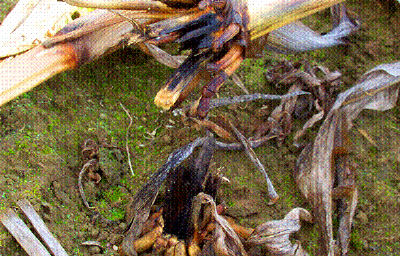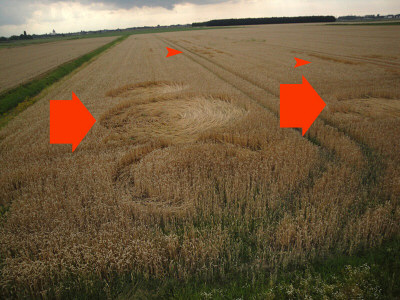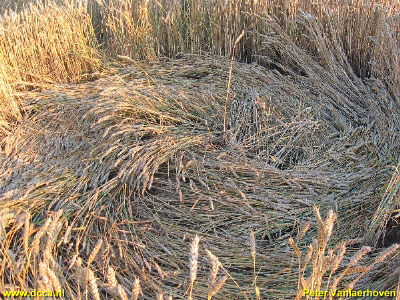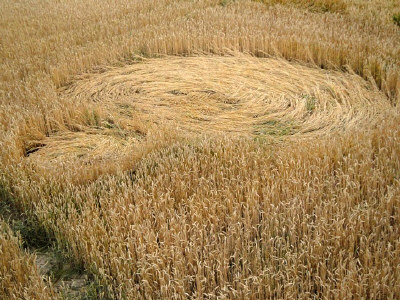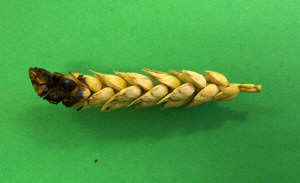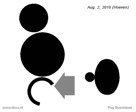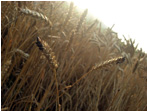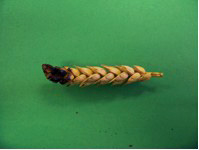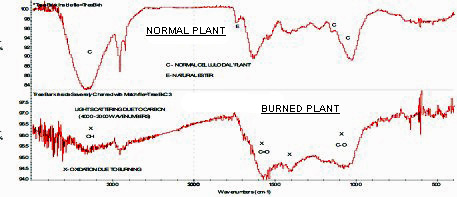CROP CIRCLE PLANTS
by
Nancy Talbott
BLT Research Team Inc.
www.bltresearch.com
We have heard many reports over the years about possibly "burned" plants in crop formations. However, in every case where these plants have been sent to BLT for examination our consulting analytical chemist has shown (through FT-IR and EDS) that the blackening was actually caused by Ustilago, an opportunistic fungus which feeds on the internal plant stem moisture which is exposed to air when the stems are crushed or broken (http://www.bltresearch.com/labreports/mission1.php).
But in 2010 seedheads from a Dutch formation which occurred in the early morning hours of August 2nd in a field in-between Hoeven and Oudenbosch have provided scientific proof of actual burning. At the end-point of a "half-ring" or "arc" component of one section of this formation, in the standing plants right at the edge of this area, there were three partially blackened seedheads and an additional plant stem with no seedhead but with a 45 angle cut which was also blackened.
At around 2:00 am on the morning of August 2, 2010 Robbert van den Broeke became aware of the very particular sensation he regularly experiences when a new crop circle is forming somewhere in his general vicinity. His intuition indicated a specific field some distance away, near the village of Oudenbosch, as the most likely location of the new circle, so he called his mother's friend Ellen Gomis and asked if she could drive him to this field.
A third interesting feature of this 2010 Dutch event is the presence of a decidedly oval circle in one section of the formation. This oval or elliptical shape has been seen in a few of the previous circles which have appeared in Robbert's vicinity but is rarely seen in crop circles elsewhere in the world.
Finally it is curious that the burned seedheads were not all affected to precisely the same degree. The seedhead submitted for analysis shows what appear to be totally normal seed pods just underneath the burned top. One of the close-up photos taken in the field, however, clearly shows dehydration of several seed-pods directly beneath the charred seed-pods near the tip of that seedhead.
We did not receive the "cut" and blackened plant stem photographed at the same location and, so, cannot determine with 100% certainty whether it's darkened end is due to burning or Ustilago. But given that the seedhead we did receive is now proven to have been burned, and the fact that the "cut" plant stem was not only observed in the same area but on the first day of the formation's existence, it's blackening is most likely due to burning also. [Blackening caused by Ustilago would take many days before being visible.]
|

![]()
17100 Wood Acre Trail
Chagrin Falls, Ohio 44023
Phone/Fax: 440-708-2211
Email: BudingerPA@MSN.com
TECHNICAL SERVICE RESPONSE NO.: UT074
Subject: |
Analysis of a Blackened Hull from a Wheat Seed-Head in a Crop Formation (near Hoeven, Holland, August 2, 2010) |
| Date: | April 1, 2011 |
| Requested By: | Nancy Talbott, BLT Research |
| Reported By: | P. A. Budinger Analytical Scientist |
|
Background/Objective:
A wheat crop formation was "seen" by Robbert van den Broeke in a vision, as it was occurring. This formed on August 2, 2010 in Holland. Roy Boschman went to the location described by Robbert as soon as it was light. He indeed found a formation. He also noted some of the seed-heads appeared to be partially burned. These were at the very end of a partially completed ring, or "arc", which was part of a formation. The objective is to determine whether the cause of the blackening was burning or ustilago fungus. Following are photographs with a graphic of the formation and an in situ photo of the blackened seed-heads. The analysis shows the seed-head top is burned. The heat it experienced appears to be localized because the bottom part of the seed-head is normal. The source of the heat is unknown. A logical speculation is that it was involved in the creation of the crop formation. The source was either hot, or there was an energy field around it that induced the seed hulls to burn.
A microscope photograph of the seed head shows definite signs of burning. The hulls are charred and partially burned away.
Infrared analysis of the blackened end of the seed-head also shows it has been burned. Spectra of the normal hull and the blackened hull were compared. The spectrum of the blackened hull is quite different from that of a normal appearing hull of the seed-head.
File: UT074
© 2010 BLT Research Team Inc. |

